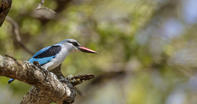
Woodland Kingfisher
Name
Woodland Kingfisher (Halcyon senegalensis)
Appearance
The Woodland Kingfisher is a medium-sized kingfisher, around 23 cm. It has a large bill with a black lower mandible and a red upper mandible. The adult has black shoulders, with a white head and neck.
The wing panels, back and tail are a bright blue. The feet and legs are dull grey in colour. The juvenile has a brown bill. The Woodland Kingfisher can often be confused with the mangrove kingfisher. The woodland kingfisher has a dark strip through the eye, where it does not extend through the eye with the mangrove kingfisher.
When flying, the woodland kingfisher has a white wingbar that is absent from the mangrove kingfisher. The mangrove kingfisher has an all red bill.
Woodland Kingfisher Diet
The Woodland Kingfisher is an insectivore, but will take small vertebrates like snakes, and frogs. They have been known to feed on small birds. The woodland kingfisher is not one of the fishing kingfishers.
Woodland Kingfisher Breeding
The Woodland Kingfisher breeds in abandoned woodpecker or natural holes in trees. 2 to 4 eggs are laid and hatch around 14 days later. Both parents assist with feeding the chicks.
Woodland Kingfisher Behaviour
This Kingfisher hunts from a low perch, swooping down to hunt its prey on the ground. On catching its prey, it will then return to its perch to beat the prey until it is stunned or dead, before consuming it.
During courtship, both sexes will perch with their wings open, displaying their bright colours.
Distribution and Habitat
The Woodland Kingfisher is an intra-African migrant and can be found in South Africa between September and December. It spends the balance of the year in Central Africa. In South Africa, it is most abundant in the acacia forests of North West and Limpopo Provinces.
